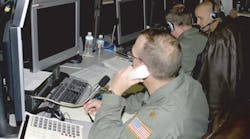ARLINGTON, Va., 27 Oct. 2007. Scientists at the U.S. Defense Advanced Research Projects Agency (DARPA) in Arlington, Va., are asking industry for revolutionary advances in high-resolution affordable emissive micro-displays (EMDs) for dynamic holography -- or real-time moving 3-D images.
Current micro-displays are expensive, optically inefficient, unsuitable for tiling into large-area displays, or are incapable of achieving long lifetimes at the necessary level of brightness and spatial resolution, DARPA officials say.
For these reasons, DARPA is excluding research that primarily results simply in evolutionary improvements to the existing state of practice for the High-Resolution Affordable EMD program (BAA 08-02). Issuing this federal broad-agency announcement are officials of the DARPA Strategic Technology Office.
This DARPA program seeks to develop a new generation of emissive micro-displays with high brightness, long lifetime, good electrical efficiency, and low cost. The displays should measure about 4 by 4 inches, should have a maximum pixel pitch of 19 microns, and a projected lifetime of 40,000 hours.
The displays also should have update rates of 30 Hz, contrast ratio of 600:1, should have 90 percent pixel uniformity, operate on 0.05 Watts, and operate in temperatures from -40 to 75 degrees Celsius.
DARPA scientists say they believe a range of emergent technologies, including Field Emission Display (FED) and Organic Light-Emitting Diode (OLED) systems, are capable of achieving several of these target characteristics.
The first phase of this research program will design and demonstrate key technological elements, and produce breadboard components of the display. The second phase will develop and demonstrate a full scale prototype emissive display that meets or exceeds DARPA requirements. One or two research contracts may be awarded.
Companies interested in participating in this program should send proposal abstracts by 9 Nov. 2007, and full proposals between 4 Jan. and 1 May 2008. The broad agency announcement remains open until 10 Oct. 2008.
Send abstracts and proposals by e-mail at [email protected], by fax at 703-807-0976, or by post at DARPA/STO, ATTN: BAA08-02, 3701 North Fairfax Drive, Arlington, Va. 22203-1714. The point of contact for this project is Douglas Kirkpatrick, who can be contacted by e-mail or by fax at the numbers and addresses listed.
For more information, this solicitation is online at http://www2.fbo.gov/spg/ODA/DARPA/CMO/BAA08%2D02/Attachments.html.


